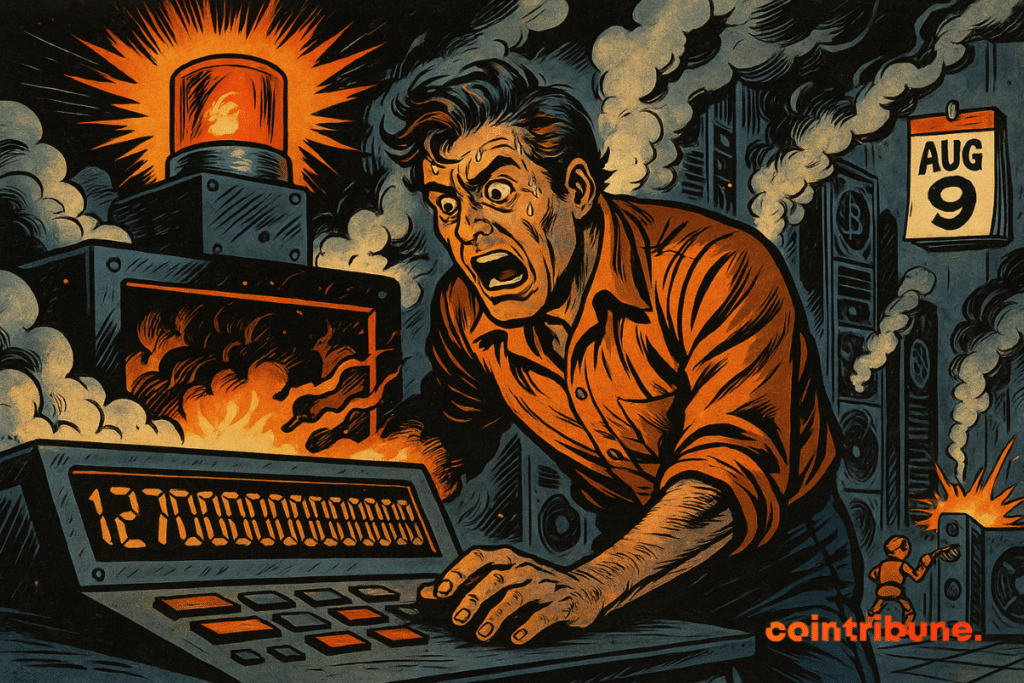Bitcoin Difficulty Surpasses 127 Trillion, Adjustment Scheduled for August 9
Summer 2025 holds a technical surprise: it is not the price of bitcoin that explodes, but its mining difficulty. At the end of July, the network reached a historic record at 127.6 trillion, a technical high revealing the computing power now mobilized to secure the protocol. This peak precedes an adjustment scheduled for August 9, expected to slightly lower the curve. But behind these numbers lies a much deeper economic logic. In an environment where scarcity and profitability intertwine, Bitcoin reminds us that its solidity is measured not only in dollars.

In Brief
- Bitcoin network mining difficulty reached a record 127.6 trillion at the end of July.
- An adjustment is planned for August 9 to bring this difficulty around 123.7 trillion.
- Bitcoin remains twice as rare as gold, with 94% of supply already mined.
- Miners earn up to $57,400 per exahash, despite a 3% drop in BTC price.
Absolute record: Bitcoin under computing pressure
The difficulty of bitcoin mining reaches a new high at 127.6 trillion, according to CoinWarz. This indicator measures the complexity for miners to solve a block. In short, the higher the number climbs, the more competitive the network is. This record level reflects an increase in global hashrate and mining intensity.
In June, difficulty temporarily dropped to 116.9 trillion, but the trend reversed by mid-July.
The next adjustment scheduled for August 9 should lower difficulty by 3%, around 123.7 trillion. This correction is required due to an average block time currently too long: 10 minutes and 20 seconds, while the protocol targets exactly 10 minutes. This self-regulation ensures the network is neither too slow nor too fast.
The adjustment cycle, every two weeks, protects Bitcoin from overproduction, ensuring the stability of its issuance schedule. The current record is not trivial: it reflects growing enthusiasm from miners, but also pressure on profitability. This technical peak is therefore both an achievement and a warning signal.
Bitcoin, rarer than gold: the central role of stock-to-flow
Bitcoin has a secret: its mathematical scarcity. According to the stock-to-flow model popularized by analyst PlanB, BTC today has a ratio of about 120. This means the current stock is 120 times higher than the new annual production. For comparison, gold caps around 60, and silver even lower. The difference? Gold can be mined without limit, whereas bitcoin is capped at 21 million units. With 94% already mined, the room for creation is shrinking.
This is where difficulty comes into play. By regulating issuance, it preserves scarcity, the key to value. This setup protects Bitcoin from supply shocks like those which historically weighed down silver prices. The system is therefore designed to limit the impact of new entrants on the price, unlike traditional metals.
This regulation has led institutions to consider bitcoin as a safe haven asset, even as a digital version of gold. But unlike gold, no industrial lobby can influence production. It is mathematically locked.
Price tension: the paradox between profitability and market
Despite the record difficulty, bitcoin price dropped by 3% at the end of July. It fell to $112,680 before rebounding to $113,375. This correction occurred while the network is more secure than ever. Hard to believe? Not really. The market reacts to economic flows, not just technical fundamentals.
In South Korea, the Kimchi premium – gap between local and global price – returned, reaching +0.84%, reflecting increased regional demand. Meanwhile, miners’ revenue jumped to $57,400 per exahash/second/day, their highest level since the halving. This contrast reveals a discrepancy: the network is more efficient, but the market remains unstable.
Analysts point to a temporary decoupling between scarcity signals (stock-to-flow) and spot price.
Bitcoin thus continues to widen the gap between its economic structure and its market performance. In this dynamic, miners adapt, optimize, and… cash out. Here are the key figures to remember:
- 127.6 trillion difficulty: record reached in July;
- 123.7 trillion expected after the August 9 adjustment;
- 94% of BTC already mined;
- $57,400 daily revenue per EH/s;
- 0.84% Kimchi premium on the South Korean market.
Despite a hashrate close to the historic peak, bitcoin miners benefit from a return to stable profitability. The network remains secure, efficient, and economically viable.
Maximize your Cointribune experience with our "Read to Earn" program! For every article you read, earn points and access exclusive rewards. Sign up now and start earning benefits.
La révolution blockchain et crypto est en marche ! Et le jour où les impacts se feront ressentir sur l’économie la plus vulnérable de ce Monde, contre toute espérance, je dirai que j’y étais pour quelque chose
The views, thoughts, and opinions expressed in this article belong solely to the author, and should not be taken as investment advice. Do your own research before taking any investment decisions.